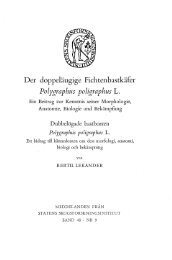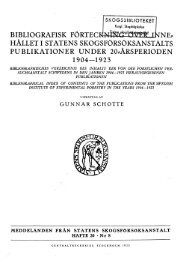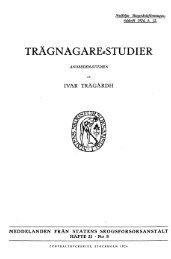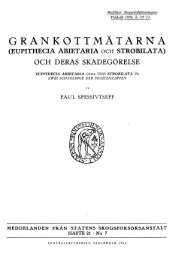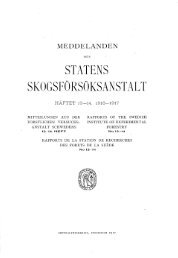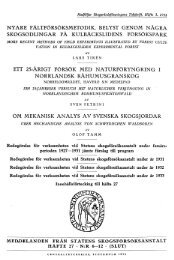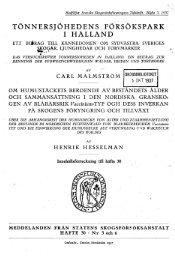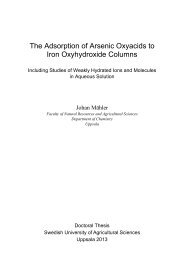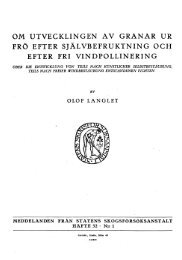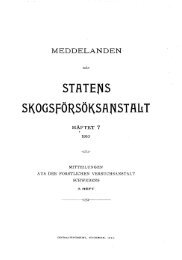Examensarbete Handledare: Kerstin Berglund Lars Ericson
Examensarbete Handledare: Kerstin Berglund Lars Ericson
Examensarbete Handledare: Kerstin Berglund Lars Ericson
Create successful ePaper yourself
Turn your PDF publications into a flip-book with our unique Google optimized e-Paper software.
ABSTRACT<br />
The anaerobe respiration ofmicroorganisms and plants promotes production oftoxic substrate<br />
like carbon dioxide and ethanol in both plant and soil. Ice and standing water limit the possibility<br />
for plants to exchange gases, which causes a deleterious situation for the plants. The<br />
problem of damage to plants during winter dormancy because of ice and standing water is a<br />
problem foremost in areas with flat topography and unstable winter c1imate (periods of freezing<br />
and thawing).<br />
The purpose of this study was to do an literature inventory of different types of damage in<br />
grassland during dormancy and to study the result from field experiment with surface<br />
drainage system and see ifthe system would reduce damage done by ice and standing water.<br />
The purpose was also to study the range of winter damage in grassland in the coastal area of<br />
Norrbotten and Västerbotten and to study different ways to overcome the problem at a<br />
number of selected farms. The problems with winter damage in grasslands in northem<br />
Sweden were investigated with help of a questionnaire. The inquiry was done among dairy<br />
farmers during the summer 200l.<br />
The literature review showed different factors causing winter damage in grassland. The<br />
different groups were farming, c1imate, biotic and plant physiologic factors. Expect for these<br />
four groups, the topography and the soil type also have an effect on the possibility for over<br />
wintering. Late last harvesting of silage, soil compaction and late supplying of nitrate<br />
fertilizer are farming factors that increase the risk of winter damage in grassland. Upfreezing<br />
of plants, standing water and ice in grassland are examples of c1imate factors causing winter<br />
damage in grassland. Fungi damage in grassland is a biotic problem. Deep snow cover that<br />
longs for a long time increase the risk of fungi damage in grassland. An example of plant<br />
physiologic is plant hardening. If the plant has a good hardiness the chance to overcome the<br />
winter problems increase.<br />
The conc1usion ofthe field experiment could not give any unambiguous results but years with<br />
problems during winter, grassland on fields with surface drainage system seems to manage<br />
the problems better than grassland on flat fields. The results from the questionnaire showed<br />
that winter damage in grassland by ice and standing water is a problem both in Norrbotten and<br />
in Västerbotten. The problem was more frequent in Västerbotten. The reason for this distinction<br />
is the difference in topography and c1imate between the both counties. The coastal<br />
region in Västerbotten is more flat and has more unstable winter c1imate than Norrbotten and<br />
because of that Västerbotten can be subjected for more and longer periods of thawing<br />
weather. Farmers that had not reported soil compaction did not have any problems with winter<br />
damage in grassland caused by ice and standing water. On farms with extensive winter damage<br />
in grassland the majority ofthe farmers had accomplished measures to limit the problem.<br />
In areas with extensive problems ofice and standing water asurface drainage system can be a<br />
good investment for good quaiity and quantity of grass. The results from the questionnaires<br />
confirm the field experience results showing that topography and c1imate are two very important<br />
factors causing problems in grassland due to ice and standing water. Farm management<br />
can change the topography and the permeability of the soil. Surface drainage systems, drain<br />
systems, surface run-off inlets and measures to minimise soil compaction are examples of<br />
measures to prevent winter damage ofice and standing water.<br />
8





